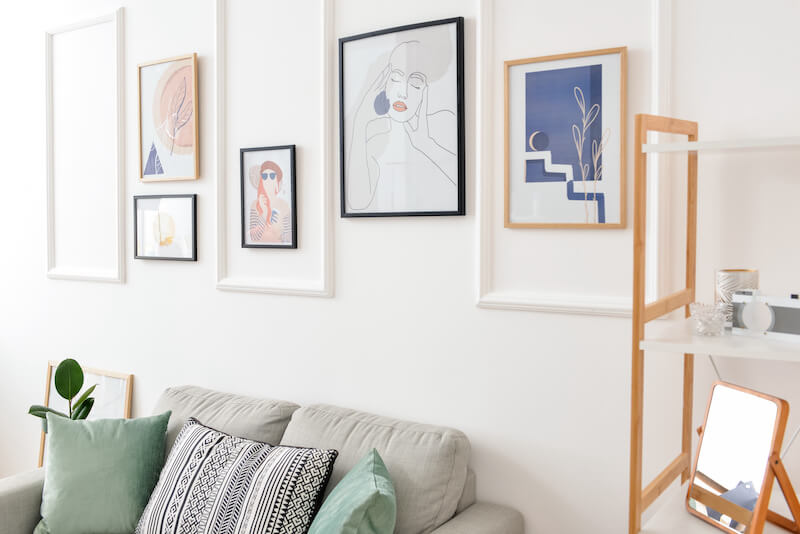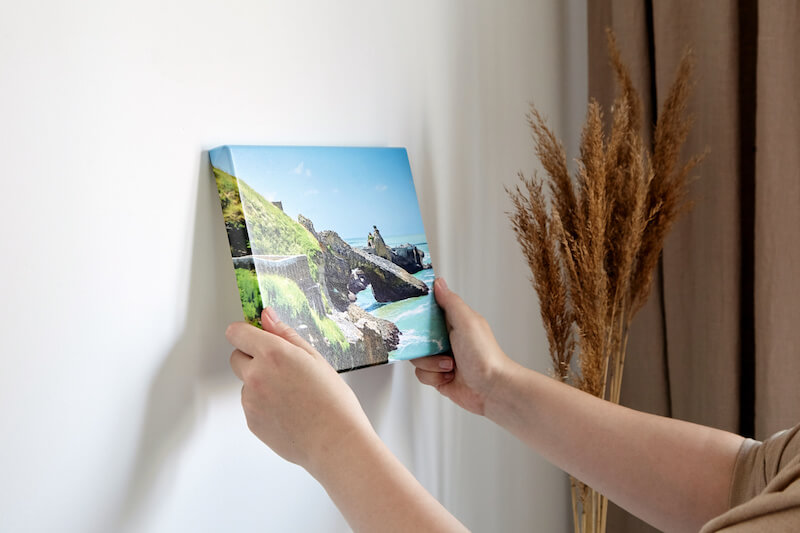When choosing wall art, deciding between canvas and framed prints can significantly impact the feel and look of your space. Both mediums offer distinct qualities that cater to different styles and preferences—whether you’re drawn to the modern, painterly effect of canvas prints or the classic sophistication of framed art. Let’s explore the pros and cons of canvas vs. framed prints to help you make the right decision.
6 Key Factors for Canvas vs. Print
- Canvas prints can be hung as-is, while art prints require frames, mats, and glass
- Canvas prints are generally more durable and low-maintenance than art prints
- Canvas prints can be made in large sizes more easily and cheaply than art prints
- Canvas prints are textured, while art prints are not
- Canvas prints can lose fine detail and sometimes color accuracy that art prints retain
- Canvas prints are typically perceived as more modern, while framed art prints are more sophisticated
What Are Framed Prints?

Framed prints are reproductions of photographs or artwork printed on high-quality paper with various finish options, such as glossy, luster, or matte. They offer an extra dimension to the artwork, providing protection through framing and a classic, elegant aesthetic that complements different interior styles. Understanding how framed prints are made, their advantages, and their potential disadvantages can help with decision-making.
How Are Framed Prints Made?
The process begins with creating a high-resolution digital file of the original artwork. This could be a digital photograph, a scanned image, or a digital painting. The quality of the print largely depends on the resolution and color accuracy of this digital file.
The digital file is then edited to match the original artwork as closely as possible. This may involve adjusting the color balance, brightness, and contrast to ensure the final print looks accurate. Artists or professionals often work on a calibrated monitor to achieve precise color matching. There are several printing techniques used for art prints, including:
- Giclée Printing: This is a popular method for fine art prints. Giclée prints are produced using high-quality inkjet printers and archival-grade inks on fine art paper or canvas. This process provides vibrant colors, sharp details, and excellent longevity.
- Lithography: This traditional method involves using plates and ink to create prints. Each color is printed separately, making it suitable for large batches of prints but less common for individual or limited-edition fine art.
- Screen Printing: Used for posters and some art prints, screen printing involves pressing ink through a stencil or mesh screen. It’s often used for bold, graphic designs.
What Materials Are Used?
Common paper materials include matte or glossy photo paper, watercolor paper, or acid-free cotton archival paper. The paper’s texture and quality can impact the print’s appearance, enhancing or changing the way colors and details appear.
Framing the print involves mounting the desired image onto a backing board within a frame. The frame, typically made of wood, metal, or plastic, adds to the overall aesthetic appeal. A glass or acrylic cover protects the print from dust, moisture, and damage.
Matting, a border surrounding the print, can be included to enhance its visual appeal and prevent it from sticking to the protective cover. This typically results in a more “finished” and professional look.
Advantages of Framed Prints
Framed prints offer timeless appeal and can be personalized to complement different interior design aesthetics. In addition to their protection, the frame or image can be swapped out separately to change the style when redecorating your home.
One chief advantage of art prints over canvas prints is that the texture of canvas can obscure fine detail and subtle color gradients. If the sharpness, clarity, and precision of the image are part of the appeal, a framed print is likely more suitable than a canvas print. Framing and matting a piece of art has a traditional, elegant appeal regardless of the art piece.
Advancements in printing technology have made it possible to achieve high-quality prints that can showcase intricate details and vibrant colors on premium paper. This guarantees that framed prints not only look visually appealing but also maintain their quality over time.
Disadvantages of Framed Prints
One notable downside of framed prints is the potential for glare caused by the glass cover. Low-glare glass doesn’t entirely mitigate the issue, and leaving off the glass in favor of low-glare protective finishes still leaves the print vulnerable to damage.
Another disadvantage of framed prints is their weight. The frame and glass add significant heft to the artwork, making large pieces cumbersome to handle and hang. Additionally, the print itself is vulnerable to creasing and other damage if not properly handled. Due to the added components of the frame and mat, the images presented by framed prints are typically smaller in size compared to canvas prints.
What Are Canvas Prints?

Canvas prints are a popular choice for those looking to add a contemporary touch to their space. Made by printing images onto canvas material and stretching them over a wooden frame, they offer a textured finish reminiscent of original paintings. Understanding how canvas prints are made and their unique advantages and disadvantages can help individuals make informed decisions when choosing artwork for their homes or offices.
How Are Canvas Prints Made?
The initial steps for creating a canvas print are largely similar to creating an art print: the image is selected, edited, and color-corrected as a digital file. Most canvas prints are created using the giclée printing technique, which uses high-quality inkjet printers with archival-grade inks.
These inks are designed to be fade-resistant, providing a vibrant and long-lasting print. Canvas prints might even use latex inks and water-resistant frames that make them suitable for humid environments like bathrooms.
What Materials Are Used?
The canvas material used can vary, including options like polyester, cotton, linen, hemp, or jute. Polyester tends to produce the most vibrant colors, while cotton canvas tends to have a more classic and textured look and is generally regarded as the highest-quality type of canvas.
Once the image is printed on the canvas, the next step is to stretch it over a wooden or metal frame known as stretcher bars. The canvas is tightly wrapped around the frame to create a neat, flat surface. This process is called gallery-wrapping, and it results in the image wrapping around the edges of the frame, giving the print a finished, frameless look.
Wrapping Options
It’s important to ensure you know exactly what type of stretching you’ll receive when ordering a canvas print. “Gallery wrap” is often used when the image itself wraps around the sides, while “museum wrap” might be used if the edges are a solid color such as black or white. Some wrapping options, however, don’t have finished edges and will require a frame.
Modern techniques typically involve using staples to secure the canvas to the frame, ensuring the durability and longevity of the print. This process results in a textured surface that closely resembles traditional paintings, adding depth and a painterly effect to the images.
Advantages of Canvas Prints
Canvas prints offer a versatile and contemporary option for showcasing artwork or photographs. The frameless look adds a sleek, modern touch and makes it easy to move the print between rooms if desired. Unlike framed prints, canvas prints don’t require mats, glass, or frames, making them lighter and more easily produced in larger sizes. Wall art can play a significant role in interior design color schemes, so having large options available at cheaper prices is a boon.
Additionally, canvas gives the impression of a painting, adding depth and character to the artwork. While you won’t get the texture of brushstrokes, the canvas texture adds tactile appeal. In addition, some artists enhance the prints with actual paint or clear gel in select areas. While they don’t have glare, some protective coatings may still result in a “shiny” appearance. Finally, hanging a canvas print is as easy as hanging a framed piece of art, so there aren’t any trade offs there.
Disadvantages of Canvas Print
A potential downside of canvas prints is that the texture and stretch of the canvas material can sometimes obscure fine details present in the images. This can be a concern for individuals who value sharpness and clarity in their art prints.
Low-quality stretcher bars can lead to issues such as warping over time, affecting the longevity and appearance of the artwork. Additionally, while you can stretch a canvas over a frame yourself, there’s definitely a learning curve.
While canvas can be framed, these prints aren’t easily swapped out of frames and are bulkier to store, making it more challenging to update the artwork. However, some varieties may actually require a frame for a finished look, adding an extra cost to the overall investment and negating several of the benefits.
Are Canvas Prints Cheaper Than Framed Prints?
When you’re talking about the same size of print, canvas prints are generally cheaper than framed art prints. A few of the factors involved include:
- Material Costs: The materials used for canvas prints—canvas fabric and stretcher bars—are generally less expensive compared to the combination of high-quality paper, matting, protective glass, and a custom frame used in framed art prints.
- Shipping Costs: Canvas prints are often lighter and less fragile compared to framed prints, which include glass or acrylic. As a result, shipping canvas prints tends to be less expensive, further reducing the total cost for the consumer.
If you have a specific budget, you can typically buy a much larger canvas print than an art print. For large art pieces, the additional framing costs for prints on paper scale exponentially. For small art pieces, the difference in cost might be much smaller. In addition, factors such as canvas or paper quality, frame or stretcher bar material, and type of ink will affect the price.
Are Canvas Prints or Art Prints Better?
The choice between canvas prints and framed prints ultimately depends on personal style and preference. Canvas prints offer a modern look, while framed prints exude classic elegance and sophistication. Consider your desired aesthetic and display preferences when choosing between the two. Ultimately, whether it’s canvas or framed prints, the most important thing is to showcase and enjoy the artwork.




